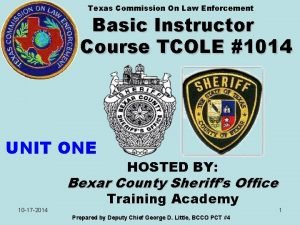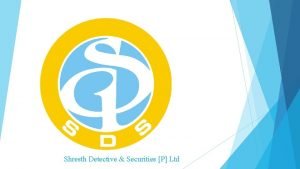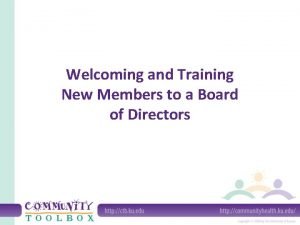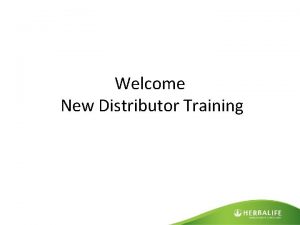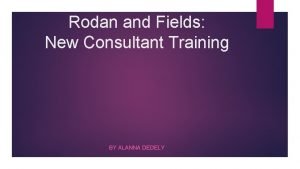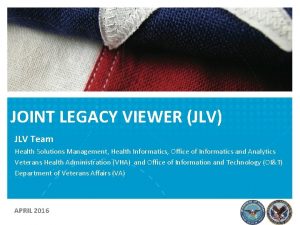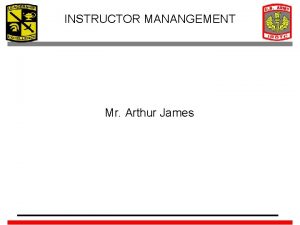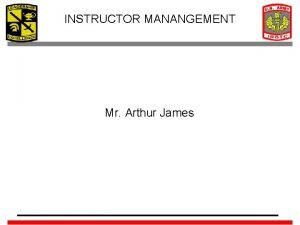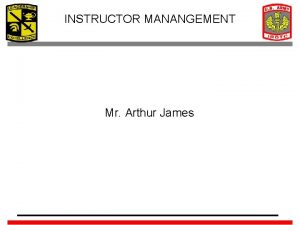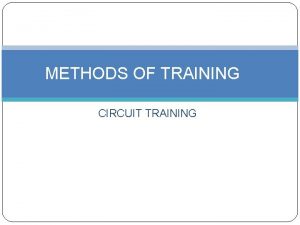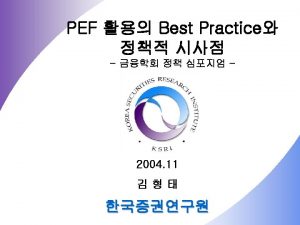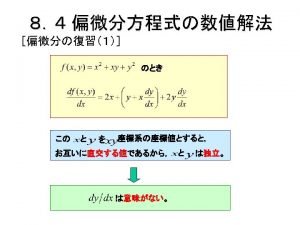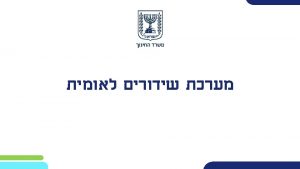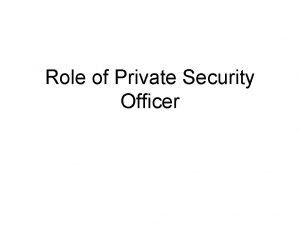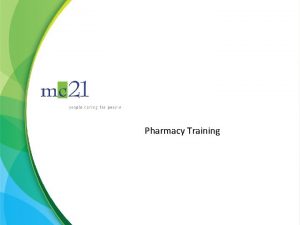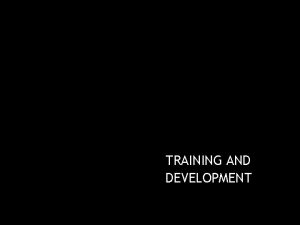Private Security New Instructor Training CIMCs Private Security














































- Slides: 46

Private Security New Instructor Training

CIMC’s Private Security Series • Developed with the Council on Law Enforcement Education and Training (CLEET) – Phase 1: Basic – Phase 2: Security Guard – Phase 3: Private Investigator – Phase 4: Firearms Training (Handgun or Shotgun) – Phase 5: Bail Enforcer

Overview of Competency-Based Curriculum Essentials

Competency-Based Curriculum Essentials • Clearly-stated learning objectives • Instruction aligned with learning objectives • Evaluation aligned to learning objectives and curriculum • Cognitive and affective skills practice • Psychomotor (“hands-on”) skill practice • Skill mastery documentation

Competency-Based Curriculum Essentials • What is a learning objective? – A specific, measurable task – Learners perform a skill or demonstrate knowledge • List in order the steps to… • Fill out a form… • Describe what the security guard should do when… – Often from national, state, or industry standards

Competency-Based Curriculum Essentials • How does instruction align with learning objectives? – Objectives indicate which level of learning is appropriate


Competency-Based Curriculum Essentials • How is evaluation aligned to learning objectives and curriculum? – Objectives indicate how learning will be evaluated – Recall, arrange, differentiate, design, etc. (knowledge or psychomotor skills) – Formative assessment: done as you teach, to see if re-teaching is needed – Summative assessment: at the end of learning

Competency-Based Curriculum Essentials • How is evaluation aligned to learning objectives and curriculum? – Performance tests – Written/cognitive tests – Quizzes – Self-checks – Rubrics (project/activity) – Portfolios

Competency-Based Curriculum Essentials • Cognitive, affective, and psychomotor skills practice – Teach, evaluate, reteach as necessary – End-of-unit review – Step-by-step checklists for psychomotor skills – Pencil-and-paper activities (Assignment Sheets) with rubrics for cognitive and affective skills

Competency-Based Curriculum Essentials • Skill mastery documentation – Profile of Training Mastery (Competency Profile) • Checklist of all learning objectives • Instructor can mark each objective off as it is mastered by the learner

What is Included in the Private Security Curriculum?

Overview of Features • • • In-depth student edition content Multiple-choice unit tests Grading rubrics for activities Teaching tips and suggested resources CD with Power. Point files Developed for use with competencybased education

Student Edition • Objective Sheet – Lists objectives covered in the unit, including handson activities (Assignment Sheets) – Serves as the unit table of contents

Student Edition • Information Sheet – Content for each objective from the Objective Sheet, other than Assignment Sheets – Icons denote online resources and discussion items – Words You Should Know – Evaluated on unit test

Student Edition • Assignment Sheet – Application activities for individual, team, or group work – Grading rubric included in Teacher Edition

Student Edition • Handout – Optional activities – Additional information for further study – Not covered on the unit test

Student Edition • Unit Review – Informal review of content from the Information Sheet to help prepare learners for the unit test – Can be used individually or discussed as a group

Teacher Edition • Teaching tips, suggestions, transparency masters, and supplemental resources aligned to specific objectives • Multiple-choice unit test covering Information Sheet objectives • Answers to tests and Assignment Sheets • Unit Power. Point files on CD packaged with Teacher Edition

How to Order • Online catalog: http: //store. okcimc. com • Or call 800. 654. 4502

Facilitating Adult Learning New Instructor Training

Characteristics of Adult Learners and Trainer Strategies • Adult learners want to know why they should learn – Relate the training to problems or situations learners will encounter as paraprofessionals – Create real-life scenarios – Show the learning process will help the learner and the students with whom the learner interacts every day – Show learners can improve or advance in a life role

Characteristics of Adult Learners and Trainer Strategies • Adult learners have expectations for learning that are based on their experiences – Respect and value their experiences; ask what they would like to know more about. – Ask questions to draw upon their experiences – Link new information to their existing experience and knowledge – Ask for their input and make adjustments – Plan alternate activities and choices

Characteristics of Adult Learners and Trainer Strategies • Adult learners are independent, selfdirected, and self-motivated – Actively involve learners in the learning process – Act as a facilitator and guide, rather than as the source of all knowledge and facts – Give them the opportunity to be responsible for their learning; engage in discussions and use presentations and group-oriented activities – Recognize that not all learners will want to learn all of the time

Characteristics of Adult Learners and Trainer Strategies • Adult learners are goal- and problemoriented – Refer to the objectives of each training module and relate content to the objectives – Stay on task; respect the real-life demands that learners face each day – Give lots of examples to connect information and application

Characteristics of Adult Learners and Trainer Strategies • Adult learners appreciate feedback – Give feedback immediately – Include a discussion item, case study, or short review quiz to summarize one or more objectives

Characteristics of Adult Learners and Trainer Strategies • Adult learners want to be respected – Know learners’ names – Avoid placing a learner in an embarrassing situation, such as highlighting a mistake – Provide low-risk activities in small group settings – Be flexible; allow time for learners to use their digital devices – Start and end the training on time and honor scheduled breaks

Qualities of Effective Trainers • Be confident – Speak loudly and directly to students – Use humor wisely and be able to laugh at yourself – Know that nervous feelings will decrease with experience – Dress in a professional manner

Qualities of Effective Trainers • Be prepared – Be sure that the lighting is adequate, the temperature is set to a comfortable level, and the furniture is arranged to best support the planned learning activities – Develop a flexible lesson plan with scheduled breaks

Qualities of Effective Trainers • Be organized – Keep all needed materials in an easilyaccessible location – Be aware of time and transition the group smoothly from one activity to the next

Qualities of Effective Trainers • Be clear – Give specific directions for each assignment and activity – Give concrete examples whenever possible – Define unfamiliar or confusing terms, names, or references – Use multiple media, including appropriate online resources

Qualities of Effective Trainers • Be engaging – Call on students by name – Present a variety of information, such as facts, examples, opinions, illustrations, statistics, or stories – Share personal experiences when appropriate – Use technology

Questioning Techniques • Be patient and do not rush • State clearly and slowly one question at a time • Focus questions on the learning objectives • Clearly phrase each question

Questioning Techniques • Give learners time to answer. Remain patient during the silence when waiting for an answer – Many trainers do not wait long enough - wait up to 10 seconds, if necessary • Direct some questions to the group and some questions to individuals

Questioning Techniques • Listen carefully to learners’ answers and provide encouraging feedback • Relate learners’ responses to other responses given in the same session to show connections

Using Small Groups • Develop tasks that are specific and concrete • Give clear, simple, task-oriented instructions • Keep group sizes to 2 -4 individuals • State the specific amount of time the groups will have to work

Using Small Groups • Have each group assign one person to record what the group discusses and report the results back to the class • Have learners share their results with the class. If alternate answers are presented, consider posting them on the board or on the course website

Learner Behaviors and Trainer Solutions • Arriving late – Set an example by always starting on time • Shyness – Stand next to these learners as you teach – Call on shy learners by name and offer nonverbal encouragement as they speak

Learner Behaviors and Trainer Solutions • Dominating discussions – Acknowledge comments and then ask for others’ contributions – Move away from the person who is dominating and focus your vision on something else • Arguing – Acknowledge the positive points and then redirect to other learners

Learner Behaviors and Trainer Solutions • Rambling – Refocus by restating the main point – Ask the learner to clarify – Ask the learner to summarize – Write the learner’s comments on the board

Learner Behaviors and Trainer Solutions • Putting the trainer on the spot – Admit that you do not know the answer, but that you will research the issue and have an answer by the next session – Redirect the question to others in the group

Learner Behaviors and Trainer Solutions • Showing obvious hostility or anger – Remain calm and polite – Do not disagree, but build around what has been said – Maintain eye contact – Give the person the opportunity to retreat gracefully from the confrontation; speak to the person privately after the session

Learner Behaviors and Trainer Solutions • Griping – Listen politely and then ask for suggestions – Request the learner to visit you afterward in order to give more time and attention to the stated concerns • Packing up early – Say something like, “You have five more minutes for which you have paid good money; I promise to end promptly”

For More Information: • Craig Maile, Manager – craig. maile@careertech. ok. gov – 405. 743. 5448 • Tracy Boyington, Instructional Development Specialist – tracy. boyington@careertech. ok. gov – 405. 743. 5516

Questions? Good Luck!

 Privat security
Privat security Tipos de participantes
Tipos de participantes Basic instructor course texas
Basic instructor course texas Basic instructor course texas
Basic instructor course texas Basic instructor course texas
Basic instructor course texas Pepperball hotshot
Pepperball hotshot Not only the students but also the instructor
Not only the students but also the instructor Instructor vs teacher
Instructor vs teacher Cisco certified instructor
Cisco certified instructor Mptc firearms instructor
Mptc firearms instructor Basic instructor course #1014
Basic instructor course #1014 Basic instructor course texas
Basic instructor course texas Virtual instructor.com
Virtual instructor.com Nfpa 1403 instructor to student ratio
Nfpa 1403 instructor to student ratio Tp 12863
Tp 12863 Instructor operating station
Instructor operating station Catia instructor
Catia instructor Instructor
Instructor Ac 61-65
Ac 61-65 Tcole 1014 basic instructor course
Tcole 1014 basic instructor course Njrotc instructor vacancies
Njrotc instructor vacancies Nrp instructor toolkit
Nrp instructor toolkit Cisco instructor certification
Cisco instructor certification What is cbrf training
What is cbrf training Nra certified instructor logo
Nra certified instructor logo Naismith was an instructor of
Naismith was an instructor of Please clean the room before you live
Please clean the room before you live Tcole advanced instructor course
Tcole advanced instructor course Tcole advanced instructor course
Tcole advanced instructor course Jrotc marksmanship instructor course online
Jrotc marksmanship instructor course online 15 sec illusion
15 sec illusion Medical terminology instructor
Medical terminology instructor Basic instructor course #1014
Basic instructor course #1014 Tcole basic instructor course
Tcole basic instructor course Delmar cengage learning instructor resources
Delmar cengage learning instructor resources Instructor office hours
Instructor office hours Six main aims of the private security industry
Six main aims of the private security industry Private security union
Private security union Sdspl
Sdspl Training is expensive without training it is more expensive
Training is expensive without training it is more expensive Metode of the job training
Metode of the job training Aggression replacement training facilitator training
Aggression replacement training facilitator training New equipment training
New equipment training Welcome board members
Welcome board members Herbalife success builder
Herbalife success builder New consultant training
New consultant training Jlv new user training quizlet
Jlv new user training quizlet
































